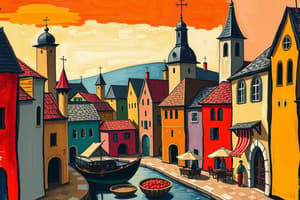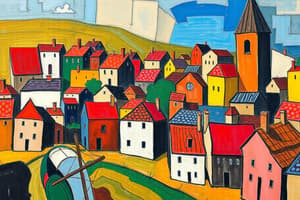Podcast
Questions and Answers
What was the primary reason for the growth of medieval towns?
What was the primary reason for the growth of medieval towns?
- Revival of trade and opening of seaport trade centers (correct)
- Increased power shift from merchants to feudal lords
- Improvement in agriculture leading to surplus crops for sale
- Desire of towns to break away from feudalism
What did the guilds oversee in medieval towns?
What did the guilds oversee in medieval towns?
- Trade and production of goods (correct)
- Military affairs and defense
- Religious ceremonies and festivals
- Healthcare and education
What did apprentices in medieval towns agree to when signing an agreement with masters?
What did apprentices in medieval towns agree to when signing an agreement with masters?
- To only work for a maximum of 5 hours a day
- To be housed, fed, and trained by the masters (correct)
- To receive financial assistance from the guilds
- To be paid a full salary for their work
What was the primary function of merchant fairs in medieval towns?
What was the primary function of merchant fairs in medieval towns?
What opportunity did the mistreatment of Jews in Christian towns provide?
What opportunity did the mistreatment of Jews in Christian towns provide?
What was the living condition like for poor families in medieval towns?
What was the living condition like for poor families in medieval towns?
What did wealthy families use the first level of their homes for in medieval towns?
What did wealthy families use the first level of their homes for in medieval towns?
What did children of wealthy families typically learn at home in medieval towns?
What did children of wealthy families typically learn at home in medieval towns?
At what age did girls typically marry and start raising children in medieval towns?
At what age did girls typically marry and start raising children in medieval towns?
What was the primary role of wealthy merchants in medieval towns?
What was the primary role of wealthy merchants in medieval towns?
What did feudalism provide in exchange for people's loyalty and labor?
What did feudalism provide in exchange for people's loyalty and labor?
What marked the end of feudalism?
What marked the end of feudalism?
What event led to the shift of power from lords to monarchs and peasants?
What event led to the shift of power from lords to monarchs and peasants?
Which city allowed people to become wealthy from trade due to its good location and defensive measures?
Which city allowed people to become wealthy from trade due to its good location and defensive measures?
Who was known for revising outdated and confusing laws, improving women's property rights, and creating the Justinian Code?
Who was known for revising outdated and confusing laws, improving women's property rights, and creating the Justinian Code?
What was the main cause of the split between the Western and Eastern Christian churches?
What was the main cause of the split between the Western and Eastern Christian churches?
What did Emperor Justinian I launch a military campaign to reclaim?
What did Emperor Justinian I launch a military campaign to reclaim?
Which architectural wonder was built by Emperor Justinian I and is considered a model for Orthodox Churches?
Which architectural wonder was built by Emperor Justinian I and is considered a model for Orthodox Churches?
'Icons' in the context of the text refers to:
'Icons' in the context of the text refers to:
'Patriarch', in the hierarchy of the Eastern Orthodox Church, holds what position in matters of religious importance?
'Patriarch', in the hierarchy of the Eastern Orthodox Church, holds what position in matters of religious importance?
'The Plague (Black Death)' led to a shift in economic social structure primarily due to:
'The Plague (Black Death)' led to a shift in economic social structure primarily due to:
Who declared icons not allowed, leading to a conflict known as 'Iconoclasm'?
Who declared icons not allowed, leading to a conflict known as 'Iconoclasm'?
What was the most feared disease during this period?
What was the most feared disease during this period?
What was the main reason for the shift in power from feudal lords to monarchs?
What was the main reason for the shift in power from feudal lords to monarchs?
What was the primary role of lords in the feudal society?
What was the primary role of lords in the feudal society?
What led to the decline of feudalism and the rise of centralized monarchies?
What led to the decline of feudalism and the rise of centralized monarchies?
Which war led to a shift in power from nobles to commoners and an increase in nationalism?
Which war led to a shift in power from nobles to commoners and an increase in nationalism?
What caused the end of feudalism?
What caused the end of feudalism?
How did common law impact the legal system?
How did common law impact the legal system?
What was the primary cause of the decline of feudal lords' power?
What was the primary cause of the decline of feudal lords' power?
Flashcards are hidden until you start studying
Study Notes
- People lived in dirty towns with no running water, used privies or chamber pots, and emptied waste into rivers or streams
- Garbage was disposed of in streams or streets, and crowded living conditions allowed for rats and fleas to thrive
- Sick people were isolated, and the most feared disease was bubonic plague, which was often blamed on Jews
- Doctors had limited medical knowledge and relied on prayer and herbs from Greek and Roman times, as well as bloodletting
- Crime was rampant, with pickpockets and thieves targeting money pouches, and punishment was brutal - some were even burned at the stake
- In 1100, common law was created, which established rulings based onjudges' decisions and old traditions
- Bubonic Plague was a deadly disease spread by fleas, causing fever, vomiting, coughing, and swelling bumps
- The plague killed 1/3 of Europe's population, leading to a shift in power from nobles to commoners and an increase in nationalism
- The Hundred Years War (1337-1453) was fought over land claims between England and France, with English forces using innovative military tactics like longbows and gunpowder
- The end of feudalism was caused by the shift in power from feudal lords to monarchs and commoners, as well as the use of military technology and the rise of a national identity.
Feudalism was needed to provide protection from external threats, such as the Vikings, Muslims, and Magyars. In feudal society, lords provided military protection to their vassals in exchange for loyalty and labor. This system allowed for a more stable and secure society in the face of constant threats from outside forces.
The end of feudalism was caused by the shift in power from feudal lords to monarchs and commoners. Monarchs were able to collect taxes and raise large armies, making them less reliant on vassals for military support. Additionally, new military technologies, such as longbows and gunpowder, made knights and castles less important, further weakening the power of the feudal lords. This shift in power led to the decline of feudalism and the rise of centralized monarchies.
Studying That Suits You
Use AI to generate personalized quizzes and flashcards to suit your learning preferences.




